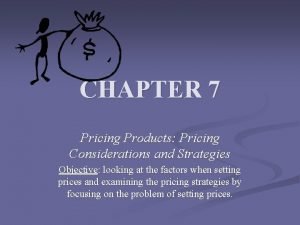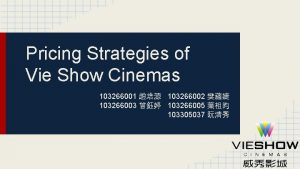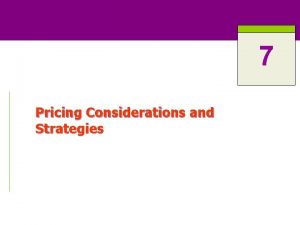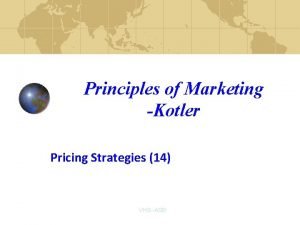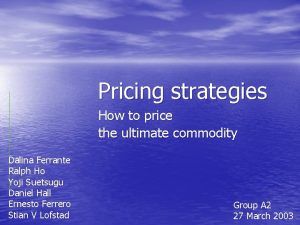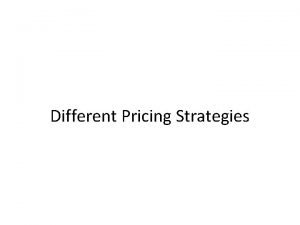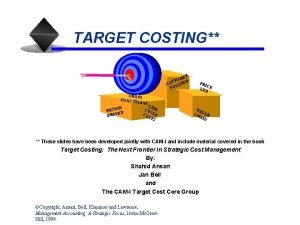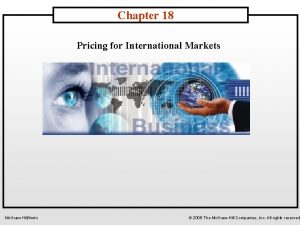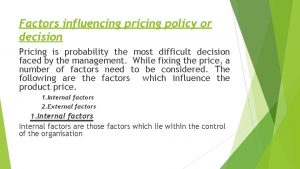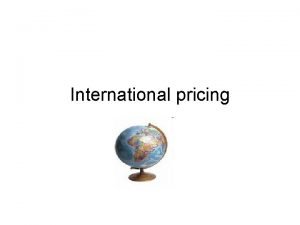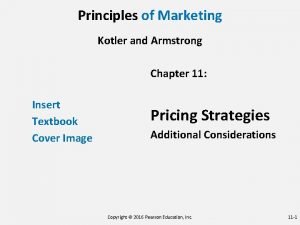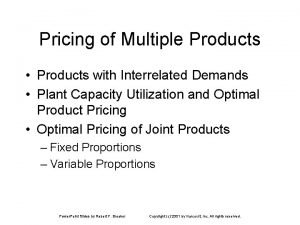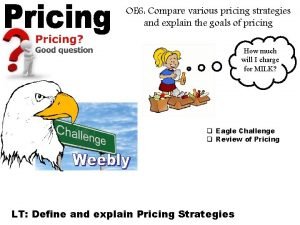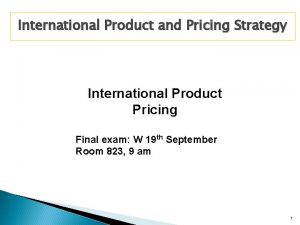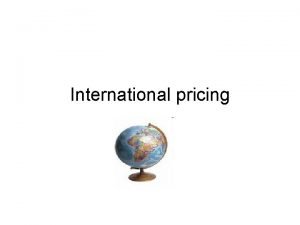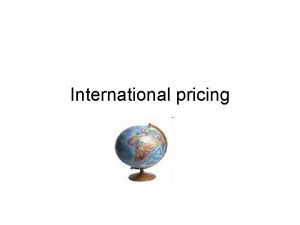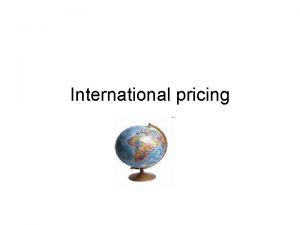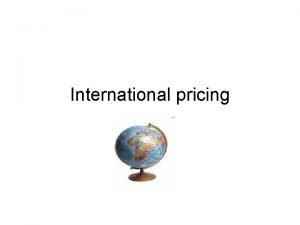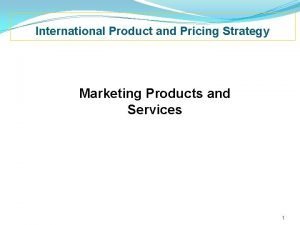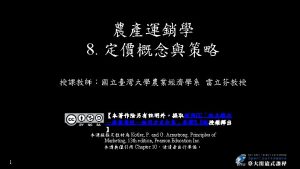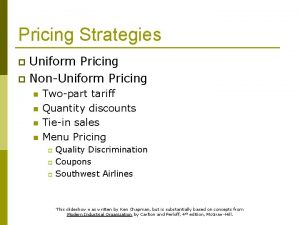International Product and Pricing Strategy International Product Pricing












































- Slides: 44

International Product and Pricing Strategy International Product Pricing Final exam: W 19 th September Room 823, 9 am 1

Country risk ratings � ICRG Country risk information (oldest source) https: //www. prsgroup. com/ICRG_Table. Def. as px � If the link does not work: www. prsgroup. com ◦ Ask for free samples �Give e-mail address and name, purpose = education �Decline contact if you wish ◦ On free samples page, click *To see a list of ICRG Tables ◦ Download the sample 2

1. Quiz 1: Pass/Fail = 50% Which is not usually considered when choosing an international brand name? A) Location of the factory that produces the product B) Whether the name is already in use in target countries C) URL (website) availability D) Local market pronunciation 2. When would a global company not choose local branding? 3. A global firm with several foreign subsidiaries can do which of the following: A) Sell their global brands under different names in different countries B) Market regional brands through host country subsidiaries C) Market a local (host country) brand through a host country subsidiary D) Any combination of the above 4. When a global firm acquires a foreign subsidiary with strong local brand equity 5. Strong brand equity in a host country would be due to which factors: A) Home country company profit B) Local familiarity and positive associations (via experience, marketing, or information from peers) C) Successfully competing with multiple brands in a category through incremental improvements D) Both a and c 6. Gaining market share typically involves A) Winning in competition among established brands through incremental change B) Finding unmet customer needs and then creating a new category or subcategory with the brand C) Risk avoidance A) When the company is targeting a cosmopolitan market segment B) The global company acquires a company with local brand equity C) When the target segment is sensitive to foreign influences A) The firm is likely to notify customers and then change the local brand name B) The old local brand name will be summarily axed (name eliminated with no notice) C) The firm may keep the local brand use it to make positive associations with a global brand D) None of the above

Fixed and Variable Costs Cost classification depends on how costs change with business activity � Fixed costs do not change with volume � ◦ Example: Management salaries, most property ◦ Fixed costs are typically allocated (full costing) � Variable costs vary in proportion to volume ◦ Examples: Direct materials, direct labor, variable factory overhead ◦ Also called direct costs Step Variable or Step Fixed costs are constant over some range, then increase � Marginal cost is the cost of an additional unit � ◦ Marginal cost of carrying one additional airline passenger is near zero if seats are available ◦ Marginal cost of one additional passenger would be high if a flight has to be added � All external reporting uses absorption or full cost � Internal decision makers may use variable costing ◦ Includes fixed factory overhead ◦ Margins are lower than with variable costing Chapter 12 4

Volume Example 1– Breakeven � COGS $6, 000 � R&D 1, 000 � SG&A 5, 000 � Total $12, 000 � COGS � Units 1, 000 � Price/unit $12 � Marginal cost $6 $12, 000 � R&D 1, 000 � SG&A 5, 000 � Total $18, 000 2, 000 � Price/unit $9 � Marginal cost $6 Chapter 12 5

Volume Example 2 – Production Run � Volume 100, 000 � Setup $ 50, 000 � Direct A* 200, 000 � Total $250, 000 � Volume � Cost/unit �* $2. 50 Ave direct cost per unit at $2. � Setup � Direct* � Total 800, 000 $ 50, 000 400, 000 $450, 000 $0. 56 �* Ave direct cost per unit at $0. 50 (A+700, 000*$0. 29) Chapter 12 6

Applying Basic Cost Concepts � Assume excess capacity (example 1) ◦ What is the lowest price a company would accept? ◦ If COGS includes $1 fixed factory cost/unit? ◦ Suppose a company prices additional units at direct cost �Would this affect the price of current units? �Where does overhead go when products are priced at variable cost? �How would a customer react to a price increase later? � Assume longer production run (example 2) ◦ Would a company accept losses on initial orders to build a market? ◦ High cost of initial production would deter prospective customers if passed through in prices ◦ Cost of expected volumes may be used for pricing when products are early in their life cycle 7

Case 1 – Marketing a New Product � � � � Vision Lenses Corporation produced a full line of contact lenses at factories in UK, Puerto Rico, USA, and Europe. The lenses were marketed globally via subsidiaries. Consumers in 2001 wanted single-use lenses for convenience and hygiene, however cost considerations made mass marketing of such lenses impractical. The lead market for disposable lenses would be Japan, where consumers were attracted to the hygiene aspect of disposables. Marketers estimated mass market possibilities in Japan if wholesale prices drop to $0. 30 per lens. Inexpensive new digital technology available in 2001 made possible the volume production of low cost single-use lenses. R&D staff knew major competitors such as Johnson and Johnson were racing to exploit the new technology. Company process engineers estimated factory cost per lens would be about $2. 00 with limited yield and efficiency during the first month of production. Within three months the cost would fall to $0. 50 per lens. At six months, with lines running at capacity, lens cost could drop below $0. 15. The head of international marketing estimated a market of 500 million lenses per year if Vision Lenses sell at $0. 30. Manufacturing would have capacity for 100 million lenses initially. The company would have to build a new factory campus to produce 500 million lens. Finance believes the company has access to sufficient capital to fund the expansion. Gross margins* on legacy products (65%) were above industry norms. Company executives believed sales of multi-use contact lenses had limited growth potential throughout the industry. Question: At what price should Vision Lenses sell the disposable lenses? * Gross margin=(Revenue-COGS)/Revenue. 8

Booz & Co. R&D Survey 2011 http: //www. booz. com/global/home/press/article/49852237 � Need Seekers, Market Readers and Technology Drivers ◦ Need Seekers consistently strive to be first movers and proactively engage customers to shape new innovations, and align innovation and business strategies (3 M) ◦ Market Readers adopt a second mover strategy and emphasize incremental change (Samsung) ◦ Technology Drivers stress technology achievement and both incremental and breakthrough change (Google) � Technological advances that lead to products and services that gain traction in the marketplace come through superior insight into customers, as well as the development of practical value propositions that will win those customers business (need seekers) � 6/10 of the most innovative were need seekers � 2/10 of the biggest spenders were need seekers

Analysis of the Apple v Samsung Outcome � � � http: //www. reuters. com/article/2012/08/25/us-apple-samsung-impactid. USBRE 87 O 02 I 20120825 ◦ Innovation is the real threat to Apple’s margins ◦ Trial publicity has made Samsung’s brand more familiar ◦ Apple and Samsung could end up cross licensing ◦ With high gross margins Samsung (or Apple) can absorb extra costs � Prices decline in a growing market � Small competitors have lower margins http: //www. ft. com/cms/s/0/b 8 b 58 c 22 -eea 2 -11 e 1 -bcf 6 -00144 feabdc 0. html#ixzz 24 c 0 I 4 qb. U Samsung sells nearly twice as many phones as Apple. Why is Apple more valuable? (Apple 2 Q profit $11. 6 bb, iphones estimated 60%; Samsung 2 Q profit $4. 5 bb, phones estimated 67% of total) ◦ Samsung's gross margin in handsets is well below the levels of Apple (estimated 58%)*: ◦ Apple’s premium brand enables it to sell its devices to telecom operators at higher prices than Samsung can command. � � Innovation enabled SE Asian shrimp able to capture foreign markets In the absence of innovation Apple and Samsung may compete on price alone. (Booz and Aaker stress importance of innovation). Lower costs and greater access to cash wins price competition – leaving few producers. � Returning to Vision Lenses: What has to happen to revenue to achieve the same profit if gross margin falls to 50%? (Sales must increase 30%) Example: Sales $200 with 65% gross margin = $130. To achieve $130 gross margin at 50% need $130/. 5=$260 sales *Product gross margins are rarely disclosed by companies. Some information was disclosed during the trial. 10

Competing on Price: Apple’s Supplier - Hon Hai � � � Apple Inc. (AAPL)’s net margins* have widened at the expense of its main supplier as Foxconn Technology Group cuts prices to retain orders for i. Phones and i. Pads. (Apple 31%, Hon Hai 1. 5%) Hon Hai is willing to sacrifice margins so it can get volume and scale, ” said Vincent Chen, an analyst at Yuanta Financial Holding Co. in Taipei who has a “buy” rating on the stock. “Apple is also getting so large that it needs a supplier that can provide such scale. ” The i. Pad is “very difficult to make, ” Hon Hai founder and Chairman Terry Gou told shareholders in June. Gou’s strategy has earned him the nickname “Low-Cost Terry, ” according to Chen. Foxconn Technology Group, which employs more than 1. 1 million people worldwide, also assembles Sony Corp. televisions, Hewlett-Packard Co. computers and Microsoft Corp. game consoles. Hon Hai’s operating margin* declined in most of the quarters in which Apple’s rose and widened when its main customer’s narrowed, the data show. Taipei-based Pegatron Corp. (4938), the only other supplier of i. Phones, also has seen its operating margin decline since getting orders for the handsets, according to data compiled by Bloomberg. Monthly factory wage South Korea (Samsung) $2, 060. China (Foxconn) $134. Figures for 2005 at http: //www. worldsalaries. org/ * Operating margin = (profit before taxes and interest)/sales. Net = (profit after t&i)/sales. http: //www. bloomberg. com/news/2012 -01 -04/apple-profit-margins-rise-at-foxconn-s-expense. html 11

Pricing Chapter Overview (Chapter 12) 1. 2. 3. 4. 5. 6. Drivers of Foreign Market Pricing Managing Price Escalation Pricing in Inflationary Environments Global Pricing and Currency Fluctuations Transfer Pricing Global Pricing and Antidumping Regulation 7. Price Coordination 8. Countertrade Copyright (c) 2009 John Wiley & Sons, Inc. Chapter 12 12

Introduction � Global pricing is one of the most critical and complex issues in international marketing. � Price is the only marketing mix instrument that creates revenues. All other elements entail costs. � A company’s global pricing policy make or break its overseas expansion efforts. � Multinationals also face the challenges of how to coordinate their pricing across different countries. � Pricing involves staff from accounting, finance, tax, legal, and manufacturing, as well as marketing. Copyright (c) 2009 John Wiley & Sons, Inc. Chapter 12 13

Drivers of Foreign Market Pricing � � Company Goals ◦ Return on investment (ROI) ◦ Market Share ◦ Specified Product Goal (image, segment) ◦ Goals may vary by country or through time. Company costs set the minimum (in most cases) ◦ Cost-Plus Pricing – prices include all costs plus a margin ◦ Flexible Cost-Plus Pricing – adjusts prices to host market conditions ◦ Incremental Cost Approach – removes domestic fixed costs (assumes overhead absorbed by home market) � Customer Demand – willingness to pay sets the highest price ◦ Consumer buying power is a factor ◦ Recall how P&G adapted pricing to the Chinese market ◦ � � Tiers target different consumer segments with slightly different products � Risk of brand dilution or cannibalization if handled poorly Pricing may involve assumptions about elasticity of demand Competition ◦ Prices may vary across borders due to levels of competition � What do competitors want? Revenue? Market share? � Test by raising or lowering price and watching response ◦ Note common practice of ‘rate shopping’ ◦ � � How is my product or service perceived relative to the competition? � A leading brand or a niche brand may be able to charge premium prices Firms may choose to compete on basis of advertising or distribution (non-price factors) Distribution Channels ◦ Trade margins and length of channels differ among countries ◦ � Large scale distributors in Europe and USA get discounts � Every day low prices (no discounts) rejected by powerful retailers Large price differentials between countries can lead to arbitrage � Movement of goods from low to high price countries � Usually done by unauthorized distributors Chapter 12 14

Government Policy Drivers of Foreign Market Pricing ◦ Taxation �Sales taxes vary among countries �Sales taxes may selectively target imports �Effect is to reduce demand for imports �Low tax countries may subsidize prices in high tax countries ◦ Price controls �Common in industries where governments often pay (pharmaceuticals) �Economy-wide response to inflation scarcity in some countries ◦ Fiscal and monetary policies �Affect interest rates (a cost) �Affects inflation and exchange rates 15

Exhibit 12 -1: Retail Price Comparisons across Cities Copyright (c) 2009 John Wiley & Sons, Inc. Chapter 12 16

Exhibit 12 -2: Price Promotions in Chinese Cultures with End-8 Prices Copyright (c) 2009 John Wiley & Sons, Inc. Chapter 12 17

Managing Price Escalation � Exporting usually adds incremental costs ◦ Shipping, insurance, and additional intermediaries ◦ Tariffs � Options to lower the export price � Position as a premium product ◦ Reduce distribution channel length (direct marketing via internet is one current option) ◦ Eliminate costly features or unbundle features ◦ Make the product smaller (usually with local branding) ◦ Assemble or manufacture the product in foreign markets ◦ Adapt the product to escape high tariffs or tax levies applied to selected categories ◦ Target upscale customers ◦ Stress product advantages 18

Pricing Strategies for Coping with Inflation � ◦ ◦ � � ◦ ◦ Shorten credit terms (better to be a borrower than a lender) Pay suppliers slowly (with cheaper currency) Collect debts quickly Include escalator clauses in long-term contracts as a hedge against inflation Quote prices in a stable currency (buyer assumes currency risk) Choose suppliers and components carefully Draw lessons from countries with a history of high inflation (such as Argentina) Published inflation figures are often unreliable Negotiate distinct rates with each supplier 19

Unreliable Official Statistics Chapter 12 http: //www. economist. com/node/21548229 20

Official Statistics Can Mislead � Since 2007, Argentine prices and the official record have been different ◦ After 1945 Argentina had periods of high inflation (4, 900% in 1989*) ◦ Faced with rising inflation due to expansionary policies after 2002, government officials used price controls ◦ In 2007 officials began to conceal inflation by applying pressure on the official statistics institute INDEC ◦ The government has gone to extraordinary lengths, involving fines and threats of prosecution, to try to stop independent economists from publishing accurate inflation numbers** � � Price. Stats, an American provider of inflation data puts the annual rate at 24. 4% and cumulative inflation since the beginning of 2007 at 137%. INDEC says that the current rate is only 9. 7%, and that prices have gone up 44% over that period. *http: //academic. reed. edu/economics/parker/f 10/201/cases/Argentina. html **http: //www. economist. com/node/21548229 21

Relative Inflation Matters � Suppose China and the USA have fixed exchange rates ◦ Assume China’s annual inflation is 5% ◦ Assume the USA has 1% annual inflation ◦ At the end of one year one $US buys 3. 8% fewer goods in China (1 -1. 01/1. 05) ◦ Same effect as stronger Chinese currency � Assume ◦ ◦ variable exchange rates Beginning exchange rate is 30 Th. B to 1$US Thailand’s inflation rate is 5% USA has 1% inflation Expected exchange rate at end of one year 1. 05/1. 01*30 = 31. 2 Th. B to 1$US 22

Inflation and Exchange Rate Example 1 � Bangkok hotel room costs 1, 500 ◦ Assume 30 baht to 1$US ◦ Cost in $US is 1, 500/30 = $50 � Assume inflation 5% Thailand, 1% USA � Assume exchange rate fixed at 30/1 ◦ Bangkok hotel room costs 1, 500*(1. 05)=1, 575 bt ◦ $50 US is now worth 50*(1. 01)=$50. 50 ◦ $50. 50*30=1, 515 ◦ Hotel room is now 1, 575/1, 515 too high (3. 96%) � Floating rate: 1. 05/1. 01*30=31. 19 bt/$1 US � Check: $50. 50*31. 19 bt/$=1, 575 bt Chapter 12 23

Inflation and Exchange Rate Example 2 � Bangkok hotel room costs 1, 500 ◦ Assume 30 baht to 1$US ◦ Cost in $US is 1, 500/30 = $50 � Assume inflation 100% Thailand, 50% USA � Assume exchange rate fixed at 30/1 ◦ Bangkok hotel room costs 1, 500*(2. 0)=3, 000 bt ◦ $50 US is now worth 50*(1. 5)=$75. 00 ◦ $75. 0*30=2, 250 ◦ Hotel room is now 3, 000/2, 250 too high (33. 3%) � Floating rate: 2. 0/1. 5*30=40 bt/$1 US � Check: 40 bt/$*$75=3, 000 bt Chapter 12 24

1. Quiz 2: Pass/Fail = 50% When inflation is higher in the host country than in the home country A) You expect a floating exchange rate to stay about the same B) The value of host country currency would fall relative to the home country C) The value of host country currency would rise relative to the home country 2. During periods of high inflation A) Governments might impose price controls B) Borrowing is generally wiser than lending C) Global companies prefer to quote prices and get payment in a stable currency D) All of the above 3. During periods of high inflation A) Government inflation statistics are the most reliable resource for pricing B) Long term contracts should include clauses to increase prices for expected inflation C) Companies can wait to collect receivables (extend longer credit terms to customers) D) All of the above 4. Assume gross margins fall from 60% to 30% and gross profit (revenue minus COGS) is $60 A) Revenue must increase 100% to generate the same $60 gross profit B) Both revenue and gross profit stay about the same C) Revenue must increase about 30% to generate the same $60 gross profit D) None of the above 5. A firm with limited supply of a popular product that has no real competitors would A) Sell at total cost per unit plus a reasonable mark-up B) Sell at variable cost in some countries to gain market share C) Target consumers willing to pay premium prices D) Both A and B 6. If a company needs to generate $100 gross profit for SG&A and half of sales is priced at variable cost A) The price of the remaining units must go up to pay for the $100 SG&A B) The remaining units should also be priced at variable cost for fairness C) Overhead is an abstract concept that has no place in the real world

Pricing in the Airline Industry From “Why Price Competition Is 'Killing' Chinese Airlines”* � � � Competition in the sector is being driven by overcapacity, says Patrick Xu, Transportation Analyst at Barclays, which is hampering the ability of carriers to raise ticket prices to meet rising fuel costs. China Southern's 15 percent rise in fuel costs in the first-half, for example, was matched by just a 3 percent increase in passenger yields. According to Xu, the trend of rising supply is set to continue, with carriers expected to see acceleration in aircraft deliveries over the next two years, as a result of orders placed back in 2010 -2011, when the outlook for demand was brighter. "Demand supply are going in the wrong direction we're seeing weakness in the yield, or ticket price, as a result of price competition. (This) is killing the Chinese airlines, " Xu told CNBC. *From CNBC, 28 August, 2012 26

Airlines as Undifferentiated Brands � Compete mostly on price on many routes ◦ Airlines add capacity as markets grow. Overcapacity happens. ◦ With overcapacity, many adopt variable cost pricing, then use capital, or borrow to stay in business (or defer maintenance) ◦ Eventually some go out of business or merge with others ◦ A few try to sell premium service (SIA, for example) � In the 1997 Asian economic crisis ◦ The Thai baht fell from 26/$1 to 55/$1 ◦ Consumers in SE Asia could not afford to travel if tickets were priced in $ at the new exchange rate ◦ Airlines flying to and from Thailand fixed prices in baht, which converted at new exchange rate ◦ A 26, 000 baht ticket cost $1, 000 in 1996, cost $473 in 1998 ◦ Airlines serving Thailand viewed Bangkok as strategic � In 2008 Thai Airlines cancelled non-stop service to NYC though ticket prices for that flight were high � Businesses in competitive industries set prices according to what the market will allow. They may exit the business when opportunities seem better elsewhere. 27

Responding to Host Country Price Controls � ◦ ◦ Governments in countries with high inflation may impose price controls Controls might be selective (only certain categories) Price controls might apply universally � Shift target segments or markets to lines with fewer controls � Consider using the high inflation country as an export base � Launch new products or variants of existing products where controls are selective � Negotiate with the government – usually on an industry basis � Predict incidence of price controls Chapter 12 28

Global Pricing and Currency Fluctuations � Stronger home country currency makes exports expensive ◦ Brands with high equity can pass through the higher host country prices to overseas consumers ◦ Firms with price sensitive customers must lower the price in home country terms (to sell at the same price in host country currency) ◦ In many cases costs decline with stronger home currency (effect of lower import prices) ◦ Firms might price to market (adjust prices to specific destinations) ◦ Price stability in host country terms is important � Use price adjustments to keep prices stable in specific markets � Can reduce company profits (Exhibits 12 -5) � Currency Quotation ◦ Buyers and sellers typically want quotes in home currency �Avoids exchange risk �Many will use a common currency, such as the Euro ◦ Forward contracts available for certain currencies ◦ Currency hedging is imperfect and expensive 29

Exhibit 12 -5: Illustration of Pass-Through and Local Currency Stability Copyright (c) 2009 John Wiley & Sons, Inc. Chapter 12 30

Export Strategies under Varying Currency Conditions Copyright (c) 2009 John Wiley & Sons, Inc. 31

Transfer Pricing � � Transfer prices are charged for sales transactions between entities of the same companies Total company pretax profit does not change due to transfer prices among wholly owned subsidiaries Individual subsidiaries will show more or less profit depending on transfer prices Example: China cogs $1=>Barbados markup 20% =>USA sells $1. 30 ◦ ◦ � Total profit =$1. 30 -$1. 00=$0. 30 Profit Barbados=$1. 20 -$1. 00=$0. 20; Profit in USA=$1. 30 -$1. 20=$0. 10 Criteria for making transfer pricing decisions: ◦ Tax regimes – companies prefer to show higher profit in low tax countries � Companies will typically place intellectual capital in low tax jurisdictions (Barbados, Ireland, Cayman Islands, etc. ) � While physical goods do not move through subsidiaries in these jurisdictions, title to the goods does pass through � A portion of profit will reside in the low tax jurisdiction � If tax rate Barbados 10%, rate USA 35%. Tax paid = 10%*$. 20+35%*$. 1=$. 055 vs 35%*$. 30=$. 105 � Tax experts have price benchmarks (intended to pass tax audits) ◦ Local market conditions – competition, goals ◦ >Host country market imperfections – price freezes, restrictions on moving profits out of a host country ◦ >Joint venture partner considerations ◦ Morale of local country managers – country manager performance based on subsidiary profits � Easily addressed via adjustments to performance targets � Anticipated low or negative profits due to strategic pricing are considered in setting performance metrics 32

An Example of Multinational Subsidiaries Parent Company Ocular Sciences, USA Direct Subsidiaries � � � Entity Jurisdiction of Incorporation Ocular Sciences Puerto Rico, Inc. Delaware M Sunsoft, Inc. New Mexico M, S Ocular Sciences Canada, Inc. Province of New Brunswick S Precision Lens Manufacturing Technology, Inc. Barbados T Ocular Sciences Australia Pty Ltd. Australia S Indirect Subsidiaries � Entity Ocular Sciences Hungary Ltd. Ocular Sciences Limited, Inc. Ocular Sciences UK Limited, Inc. Sidecastle Limited Ocular Sciences Cayman Island Corp. Ocular Sciences - SAS Ocular Sciences - BV Ocular Sciences - Gmb. H Ocular Sciences - Sarl Ocular Sciences - Ap. S Ocular Sciences - Srl Ocular Sciences - KK � Note: Principle activities: M=manufacturing, S=sales, T=intellectual property � � � Jurisdiction of Incorporation Budapest, Hungary S United Kingdom M Ireland T Cayman Island T France M, S Netherlands S Germany S Switzerland S Denmark S Italy S Japan S Chapter 12 33

Setting Transfer Prices � � � Marketing is rarely involved in tax related transfer prices Market-based transfer pricing to foreign sales subsidiaries �Arm’s length prices are based on market prices �Market prices might be missing due to lack of competition Nonmarket-based pricing: �Cost-based pricing adds a markup to cost of goods �What is a fair allocation of corporate overhead? This is always a question in cost based pricing. �How do entities split profit? �Negotiated pricing often occurs within companies �Elicits cooperation among divisions �Creates an incentive toward information sharing and best practices within the company � � � Compliance with financial reporting norms, fiscal and custom rules, and anti-dumping regulations prompts use of marketbased transfer pricing. Government-imposed market constraints such as import restrictions, price controls, or exchange controls favor nonmarket-based transfer pricing. Most firms use a mixture of market-based and non-market pricing procedures 34

Exhibit 12 -7: Decision-Making Model for Assessing Risk of TP Strategy Copyright (c) 2009 John Wiley & Sons, Inc. Chapter 12 35

Global Pricing and Antidumping Regulation � Dumping occurs when imports are sold at a prices thought to be below cost or below home country price ◦ Low priced imports may threaten local industries ◦ Governments may then levy tariffs or fines to protect local producers ◦ WTO member countries have guidelines about what can be penalized as dumping (these evolve through time) � Voluntary Export Restraint (VER) may be a response to a threat of anti-dumping action � Exporters can reduce risk of antidumping actions ◦ Move away from price competition by adding value ◦ Cooperate with local competitors in the host country 36

Coordinating Prices Between Countries � � Large price differences between countries create arbitrage opportunities (gray markets) Price coordination among countries is affected by ◦ Nature of customers � Do customers have easy access to price information? �Can they exploit differences? �Internet has a role in price convergence - ability to compare prices ◦ Amount of product differentiation between countries �Product might not be suitable for use in the same form �Products might be adjusted to local market conditions ◦ Nature of channels - cross border channels require more price coordination ◦ Nature of competition �Global competition requires more coordination of prices �Local competition requires fast response to price local changes ◦ Market integration – elimination of barriers to movement of goods between countries requires similar prices ◦ Internal organization – country affiliates might demand autonomy ◦ Government regulation – government purchasers might require prices equal to other countries � Purchasers may demand Global-Pricing Contracts from suppliers Chapter 12 37

Implementing Price Coordination � ◦ ◦ Pricing Corridor � � � ◦ ◦ � � Increase prices in low-price countries and lower them in high-price countries Determine price for each country which maximizes company-wide profit Look for gray market (arbitrage) opportunities if price differences between countries are large Gray markets potentially damage authorized distributors Product differentiation between countries discourages arbitrage Intelligence systems needed to monitor gray markets Set a pricing corridor with a range of acceptable prices Goal is to maintain companywide profit while allowing flexibility Some profit is sacrificed by setting bounds to prevent arbitrage Four ways to implement price coordination within global organizations Economic measures such as transfer prices or purchase limits Centralization of pricing decision making Formalization - country managers allowed flexibility within boundaries Informal coordination – use persuasion and discussion among country managers In stable environments among similar markets centralization works Complex and changing market conditions require flexibility 38

Countertrade � � Transactions that involve non-cash compensation Forms of Countertrade (See Exhibit 12 -9. ) ◦ Simple barter – swap of one product for another ◦ ◦ ◦ � Common among subsistence economies � Sometimes used in recoveries from cash poor debtors Clearing agreement – governments agree to a given volume of imports from each other � Volumes are monitored � Imbalances are settled in cash or goods Switch trading is a clearing agreement with a third party getting rights to imbalances (credits used to buy goods) Buyback (compensation) is typically used for capital equipment, major projects. These give the seller rights to some portion of the product of the project or equipment Counterpurchase is the most popular form of countertrade � Parties agree to buy goods from each other over a period of time � Goods can be unrelated Offset (seller agrees to buy from importer’s country, or to transfer technology to the country) is common with defense purchases � Direct offset is an agreement by supplier to use product materials from the importing country � Indirect offset involves goods unrelated to the core goods Chapter 12 39

Exhibit 12 -9: Classification of Forms of Countertrade Copyright (c) 2009 John Wiley & Sons, Inc. Chapter 12 40

Reasons for Doing Countertrade � Gain access to new or difficult markets � Overcome exchange rate controls or lack of hard currency � Low credit worthiness of one party � Increase sales volume � Generate customer goodwill for the long term ◦ Markets may lack cash ◦ Competitors may offer countertrade for access ◦ Official exchange rates may be far from market rates ◦ Some currencies (Soviet ruble for instance) not convertible ◦ Buyer might have limited access to credit or face high borrowing costs ◦ Countertrade offers a way around credit barriers ◦ Dispose of surplus items ◦ Increase sales to absorb overhead ◦ After credit or currency situation improves the seller may be favored ◦ Seller gains expertise in emerging market or transition situations Chapter 12 41

Problems with Countertrade � Shortcomings of Countertrade: ◦ Goods not used by the buyer need to be sold ◦ ◦ ◦ � � Some firms rely on brokers � Poor quality or lack of demand may make sale difficult Timely and costly negotiations � Valuation of goods � Type of goods � Timing Uncertainty and lack of information on future prices � Commodity prices are volatile � Value may decline before goods can be sold or exchanged � Quality issue for many types of goods Transaction costs � Cost of finding buyers (if goods can not be used by the buyer) � Hedging costs for commodities � Broker commissions (if brokers are used) Problems in countertrade – Latin America ◦ ◦ ◦ Complex negotiations take time Cost increases Quality of goods Difficulty selling received products Third party involvement Loss of flexibility 42

1. In variable exchange rate situations Quiz 3: Pass/Fail = 50% A) Exporters prefer to use the currency of the host country B) Importers want to pay in the currency of the seller’s country C) Buyers and sellers want to use their country’s currency to escape exchange risk D) Both A and B 2. When the home country currency gets stronger, exporters may A) Absorb the effect of a strong home country currency to keep export prices stable B) Do sourcing outside the home country C) Move more production outside the home country D) Any of the above 3. If a company sells the same product at different prices in different countries A) A gray market might develop to arbitrage price differences (take advantage of price differences) B) The company may be responding to different price sensitivities among the countries C) Levels of competition might vary among different countries D) All of the above 4. To prevent gray market exploitation of product price differences across countries A) A company could adapt product formulas to local taste B) Make internet price comparisons easy C) Standardize the product across all countries D) None of the above 5. Cost of product at A is $100. Transfer price to B is $120 and then B sells it for $125 A) Total company profit is $5 B) Company profit is $120 + $125 -100 = $145 C) Profit in B is $5 D) None of the above 6. When a product is sold through a joint venture partner in the host country A) The multinational should raise transfer prices to capture profit from the joint venture partner B) Transfer prices should be based on mutually agreed upon criteria, such as cost plus a markup C) Transfer prices from the multinational to the joint venture have no impact on partner profits

Anti-dumping in the news NYT: “Europe to Investigate Chinese Exports of Solar Panels” � � � � The European Union is preparing to begin a broad investigation into whether Chinese companies have been exporting solar panels for less than cost The anti-dumping case follows a series of bankruptcies and factory closings by European and U. S. solar panel manufacturers The U. S. Commerce Department imposed preliminary anti-dumping tariffs in May of at least 31 percent on Chinese solar panels, in addition to preliminary anti-subsidy tariffs of 2. 9 percent to 4. 73 percent that were imposed in March. The Chinese government has responded by accusing American producers of polysilicon, the main material used in solar panels, of engaging in unfair trade practices and has threatened steep tariffs on the producers. The United States and the Union each follow elaborate, quasi-judicial procedures for anti-dumping and anti-subsidy cases, taking statements from affected companies before acting, and following detailed rules for setting any tariffs. China’s methods for assessing trade penalties are relatively mysterious. Chinese companies played a tiny role in the global solar power industry until five years ago, when they began a surge that has now brought them two-thirds of the global market. That rapid growth has been accompanied by a steep plunge in wholesale prices for solar panels, which have dropped by up to three-quarters in the past four years. Chinese industry officials and regulators insist that their huge investments in big new factories have brought down costs. But big Chinese solar companies have been posting heavy losses, particularly in the second quarter. The Chinese solar power industry now has too much capacity. http: //www. nytimes. com/2012/09/06/business/global/eu-prepares-to-investigate-chinesedumping-of-solarpanels. html? pagewanted=2&nl=todaysheadlines&emc=edit_th_20120906 44
 Going rate pricing example
Going rate pricing example Product mix pricing strategies
Product mix pricing strategies Product safety and pricing
Product safety and pricing Tesla objectives
Tesla objectives Vieshow ticket price
Vieshow ticket price Pricing strategy conclusion
Pricing strategy conclusion Differential pricing strategy
Differential pricing strategy Optional product pricing
Optional product pricing Optimum pricing strategy
Optimum pricing strategy Starbucks 4 p's of marketing
Starbucks 4 p's of marketing Marketing kotler
Marketing kotler Destroyer pricing examples
Destroyer pricing examples Commodity pricing strategy
Commodity pricing strategy Parking pricing strategy
Parking pricing strategy Workbench pricing strategy
Workbench pricing strategy Mba pricing strategy
Mba pricing strategy Pricing techniques used by retailers
Pricing techniques used by retailers Principles of marketing pricing strategy
Principles of marketing pricing strategy Benchmark pricing strategy
Benchmark pricing strategy Price lining
Price lining Entry deterring pricing
Entry deterring pricing Food truck weaknesses
Food truck weaknesses Setting prices and implementing revenue management
Setting prices and implementing revenue management Factors affecting pricing strategy
Factors affecting pricing strategy Price strategy
Price strategy Target pricing strategy
Target pricing strategy Penetration pricing adalah
Penetration pricing adalah Demand based pricing
Demand based pricing Business strategy vs corporate strategy
Business strategy vs corporate strategy Level strategy aggregate planning example
Level strategy aggregate planning example Pricing for international markets
Pricing for international markets Factors influencing international pricing
Factors influencing international pricing International pricing process
International pricing process International pricing strategies
International pricing strategies International pricing objectives
International pricing objectives Transnational strategy vs global strategy
Transnational strategy vs global strategy Home replication strategy
Home replication strategy Armstrong chapter 11
Armstrong chapter 11 Multiple product pricing
Multiple product pricing Optional product pricing
Optional product pricing Product line pricing
Product line pricing Product line pricing
Product line pricing Captive-product pricing
Captive-product pricing Product form segment pricing
Product form segment pricing Product pricing examples
Product pricing examples
